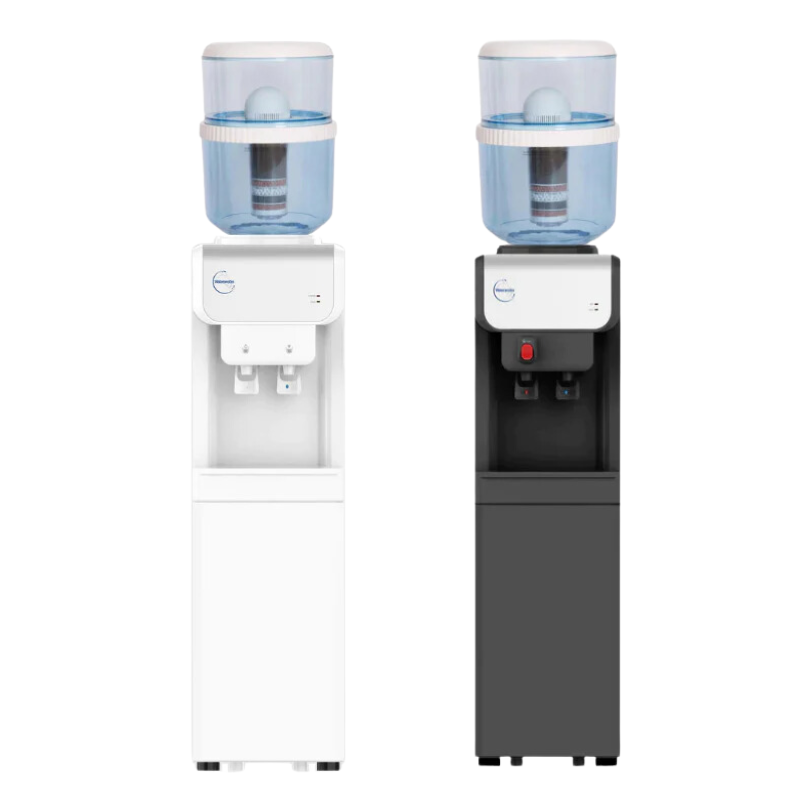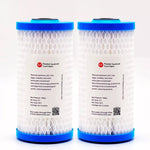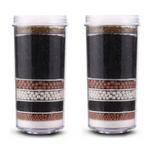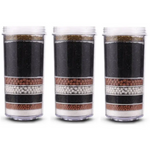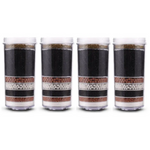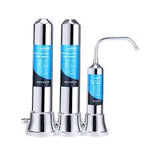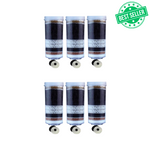You have no items in your shopping cart.
If you're concerned about the fluoride levels in your drinking water and are considering ways to reduce or remove it, this guide is for you. We'll explore various water filtration methods, how effective they are at removing fluoride, and whether you should consider filtering fluoride out of your water. Dive in to make an informed decision about your drinking water quality.
Table of Contents
- Should You Remove Fluoride from Water?
- Do Water Filters Remove Fluoride?
- Water Filters That Remove Fluoride
- Water Filters and Fluoride
- How Does Excess Fluoride Affect Our Health?
- How Much Does a Water Filter That Removes Fluoride Cost?
- Final Thoughts

If you're worried about the excessive fluoride levels in your drinking water, you might want to consider investing in a water filter. However, do water filters remove fluoride?
There are various models to select from, each with its own set of outcomes. Keeping track of them all can be difficult, but we're here to help! We'll walk you through the different options and discuss how effective each is.
SHOULD YOU REMOVE FLUORIDE FROM WATER?
In the 1940s, only one water source was fluoridating water. Now, it expanded to 67 percent of US homes receiving fluoridated water today.
According to experts, fluoride levels in drinking water should be "no more than 0.7 mg/L" to prevent dental fluorosis in children.
Many people, however, are beginning to doubt whether fluoridating public water supplies is such a good idea.

DO WATER FILTERS REMOVE FLUORIDE?
A basic technique for removing fluoride from drinking water is a reverse osmosis filtering system. A Reverse Osmosis (RO) system may remove 85-92%* of fluoride from your water.
Reverse osmosis technology works by forcing tap water through the filtration process using household water pressure. Water is filtered through a semipermeable membrane and sediment and carbon filters (many RO units incorporate a 4-stage process for optimal water quality).
Other water filters can filter fluoride from your tap water. Read more, and you'll find out.
WATER FILTERS THAT REMOVE FLUORIDE

Benchtop Water Purifier showcase installed Ceramic Dome, 7 Stage Water Filter, Magnesium Prill Beads, and 97% Ceramic Fluoride Water Filter
Benchtop Water Purifiers: A Simple Way to Remove Fluoride
If you're living in a rental or just want something easy to set up, a benchtop water purifier is a fantastic option. There's no plumbing required, and they’re super convenient — just set it up on your counter and enjoy cleaner, better-tasting water.
Many high-quality benchtop filters are just as effective as under-sink models when it comes to removing unwanted contaminants like fluoride. The key is choosing the right filter media.
For example, fluoride ceramic filters are specially designed to reduce fluoride levels in your drinking water. Pair that with multi-stage filtration (like KDF or activated carbon), and you’ve got a powerful, everyday solution without any complicated installation.
We Recommended These Filters if you're looking to filter other impurities, including fluoride ofcourse!
- Fluoride Ceramic Water Filter - Perfect for gravity-fed or benchtop purifiers to effectively reduce fluoride and other impurities.
- 7-Stage KDF Water Filter Cartridge - Offers layered protection including chlorine, heavy metals, and fluoride, plus it helps balance water pH with natural minerals.
Reverse Osmosis

Removing fluoride from water is particularly successful with reverse osmosis systems, also known as RO systems. In these filters, water goes through a semipermeable membrane, trapping contaminants. It works well, removing more than 95 percent of fluoride from your water.
The majority of RO systems are under-the-sink water filters. They'll have to be plumbed in, which shouldn't be too difficult. Filter only the water you want for drinking or cooking by using them with a separate tap.
On the other hand, RO systems have one drawback: they produce effluent. Why not cleanse all of your drinking water with it? And, even though it is adequate for most purposes, it will most likely flush that water down the toilet.
It's not good for the environment. It won't be good for your bills if you have a metered water supply!
If you're renting or don't want to install a system, countertop RO water filters are available. You'll have to replace the cartridges more regularly because these filters are smaller than under-sink water filters. However, they are both equally effective in eliminating fluoride.
It's vital to realize that a reverse osmosis system filters out practically all contaminants in the water. The water is slightly acidic and mineral-deficient as a result.
On your own, you can remineralize and alkalize the water. An easier solution is to find a RO system that does it for you. There are numerous alternatives to choose from. Check for remineralizing and alkalizing media in the product description.
Gravity Water Filter
Some excellent gravity water filters can also remove fluoride. These allow gravity to drain water through a ceramic filter easily.
When it comes to filtering fluoride, they can be even more effective than RO systems. In some units, it lowers the fluoride levels in your water by at least 97 percent.
They're also less costly than RO systems, even though they don't remove as many pollutants.
Because they are sluggish, they are also suited for tiny households with modest water demand. If you can live on 5 to 9 liters of water each day, they could be a viable option.
Countertop Water Filters
If you're looking for a fluoride water filter, there are some fantastic countertop water filters available.
However, these can be quite huge, especially if it includes extra filter cartridges. As a result, you should anticipate losing some space on your work surface.
They're easy to put together. Unscrew your faucet's aerator and replace it with the connector. It is necessary to turn a lever to filter the water. As a result, you can use unfiltered water for daily tasks while also prolonging the cartridge life.
Pitcher with Water Filter
Look at the design of the water filter pitcher to check if it can filter fluoride. Many well-known pitcher manufacturers use simply activated carbon to filter out pollutants. That's great for a number of contaminants, but fluoride isn't one of them.
Some pitchers include fluoride filters, so check the specifications. They're a good choice for filtering small amounts of water at a time. They also have a number of advantages over other types of filters.
You can chill them in the refrigerator. Unlike RO systems, they do not produce wastewater. It also doesn't too much space as countertop water filters. They are also highly cost-effective.
Whole House Water Filter

It uses activated carbon in several whole-house water filter systems, such as water filter pitchers. When it comes to fluoride, this means it's pointless.
In whole-house systems, however, it uses activated alumina media. Fluoride will be removed by these filters, but not to the same level as other filters. Some units show a fluoride reduction varying from 70 to 96 percent. Double-check the specifications before making a purchase.
There are also whole-house reverse osmosis systems available. An extra storage tank and pump, however, will be necessary.

Ace 4L Medical Pure Water Distiller Purifier Filter w/ Jar
Water Distiller
While not exactly a water filter, distillation is a great method for removing fluoride from water. You may distill water without using any special equipment, but it's a difficult and time-consuming process. Purchasing a water distiller will greatly simplify your life.
Seek options that do not contain plastic pieces to prevent cross-contamination of your water. Most only hold around two liters of water at a time, leaving them excellent for families with low water consumption. Keep in mind that you'll need to plug them in for them to sit on your counter.

WATER FILTERS AND FLUORIDE
Fluoride, a chemical added to water in many regions to help prevent tooth decay, can be difficult to remove. GAC or catalytic carbon will not be able to remove it. A reverse osmosis system is the most effective and cost-effective way to remove fluoride from your water, and a combination of the two is frequently the best option.
Bone char is a kind of activated carbon produced from animal bones that have been carefully picked and cleaned. A substance called hydroxylapatite is abundant in most animal bones. It's a type of calcium apatite that is particularly fluoride-attractive. When bone char is exposed to fluoride-containing water, the filter exchanges the fluoride ions for hydroxide ions, effectively eliminating the fluoride ions from the water. This filter can remove up to 90% of fluoride from drinking water.
A reverse osmosis system can help reduce the quantity of fluoride in drinking water. Reverse osmosis (RO) is a process that drives water through a membrane with extremely small holes that restrict almost everything but clean water from going through. RO filters, like bone-char filters, are thought to remove roughly 90% of fluoride. The most effective treatment strategy may be a mix of RO and bone char.
HOW DOES EXCESS FLUORIDE AFFECT OUR HEALTH?

Water fluoridation's most obvious sign is dental fluorosis. Fluorosis is a disease that primarily affects children aged eight and under while their teeth are developing. Fluorosis is not a public health issue, and it only has a cosmetic effect on teeth, causing white streaks or dots on the enamel. The World Health Organization (WHO) and the Centers for Disease Control and Prevention (CDC) are still researching the effects of extended fluoride use on human populations (CDC).
Fluoride consumption that exceeds the WHO's concentration standards has more severe consequences, such as severe dental and skeletal fluorosis, leading to brittle bones/teeth, joint impairment, and thyroid gland damage. Water fluoridation opponents argue it raises bone cancer risk, but the research is still ongoing. Opponents further allege that it violates moral and human rights because it is an involuntary "mass medication," fluoride consumption is not individually controlled. It means that children, individuals who sweat a lot, people with kidney difficulties, and people with other impairments consume more than the normal person.
HOW MUCH DOES A WATER FILTER THAT REMOVES FLUORIDE COST?
All water treatment systems require routine maintenance to function correctly. Filtration systems range in price from around $20 for simple units to hundreds of dollars for complex systems that require professional installation. Consider the cost, timing, and convenience of maintenance, such as filter cartridge replacements, in addition to the expense of buying and installing the system.
Reverse osmosis has grown in popularity because it is a safe, cost-effective, and simple-to-maintain water filtration system. For about cents per gallon, a family of four may have clean, great-tasting RO-filtered water every day. The average cost of a new reverse osmosis system is less than $300.
A domestic RO system has a compact footprint and is usually put under the kitchen sink. You can also connect your refrigerator and ice maker to the system.
A whole-house reverse osmosis system, typically installed in a home's garage, enables you to have filtered water at all taps around the house. However, most homes consider this system to be prohibitively expensive. It's because there are high continuing maintenance expenses and pre-filtration requirements before the water enters the RO system.
Instead, we recommend installing a small reverse osmosis water filter system for drinking water at the kitchen sink to remove fluoride. Installing a UV lamp water filter to protect all water coming into your home from microbes like viruses and bacteria is also a good idea.
FINAL THOUGHTS
Fluoride is present in all of our water sources naturally. Fluoride in the appropriate amounts in drinking water can help prevent tooth decay. All water used to drink or prepare drinks like infant formula is considered drinking water, as is water used for cooking.
But they said too much of something might be bad for your health. If you're worried about too much fluoride in your water, water filters can come to your rescue. Here at Ace Water Coolers, we offer different types of water filters that remove fluoride in Australia. Browse through our store, and you might find the one that suits you best. Ace Water Shop Australia looks forward to hearing from you!

